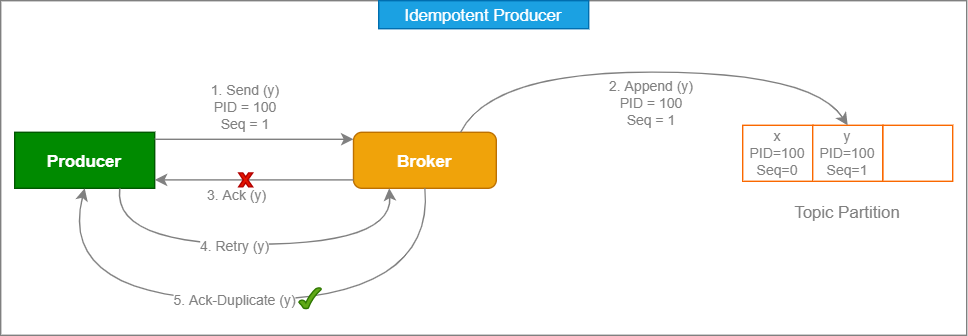Idempotent Producer in Kafka
Idempotent Producer in Apache Kafka ensures that messages are delivered exactly once to a topic, even if there are retries due to transient failures. This feature is crucial for preventing duplicate messages, especially in distributed systems where network issues or broker failures might cause the producer to resend messages.

How Idempotent Producer is Achieved
-
Producer ID (PID):
- When a Kafka producer is initialized, it is assigned a unique Producer ID (PID). This PID is used to track the producer’s operations and ensure idempotency across message retries.
-
Sequence Numbers:
- Each message sent by the producer is tagged with a sequence number. This sequence number is unique within the context of the PID and increments with each message.
- The broker keeps track of the last sequence number received for each partition from a specific producer. When a new message arrives, the broker checks the sequence number:
- If the sequence number is greater than the last seen, the message is accepted and the sequence number is updated.
- If the sequence number is less than or equal to the last seen, the message is considered a duplicate and is discarded.
-
Acknowledgments (ACKs):
- The producer can request acknowledgments from the broker (e.g.,
acks=all). This ensures that a message is only considered successfully sent if all in-sync replicas have acknowledged it, further reducing the risk of duplicates.
- The producer can request acknowledgments from the broker (e.g.,
-
Retries and Idempotency:
- If a producer does not receive an acknowledgment, it will retry sending the message. Thanks to the sequence numbers, the broker can identify and discard any duplicate messages that result from these retries.
Why Idempotent Producer is Used
-
Data Integrity:
- In distributed systems, network failures, broker crashes, or other transient issues can lead to message duplication if not handled correctly. The idempotent producer ensures that each message is delivered exactly once, maintaining data integrity.
-
Simplified Consumer Logic:
- With idempotency guaranteed at the producer level, consumers don’t need to implement complex logic to detect and handle duplicates, making the system more reliable and easier to manage.
-
Reliability in High-Throughput Systems:
- Kafka is often used in high-throughput environments where data duplication can lead to significant issues, such as incorrect analytics or triggering the same action multiple times. The idempotent producer helps prevent these problems.
-
Support for Exactly Once Semantics (EOS):
- Idempotent producers are a key component in Kafka’s support for Exactly Once Semantics (EOS). When combined with Kafka transactions, it ensures that a series of operations are either fully completed or fully rolled back, even in the presence of failures.
How to Enable Idempotent Producer
Idempotency in Kafka is enabled by setting the producer configuration parameter:
enable.idempotence=true
This setting is sufficient for most use cases, as Kafka will automatically handle the PID, sequence numbers, and other details internally.
By enabling idempotent producers, you significantly increase the reliability of your Kafka-based applications, ensuring that even in the face of retries, your system behaves predictably and data is not duplicated.